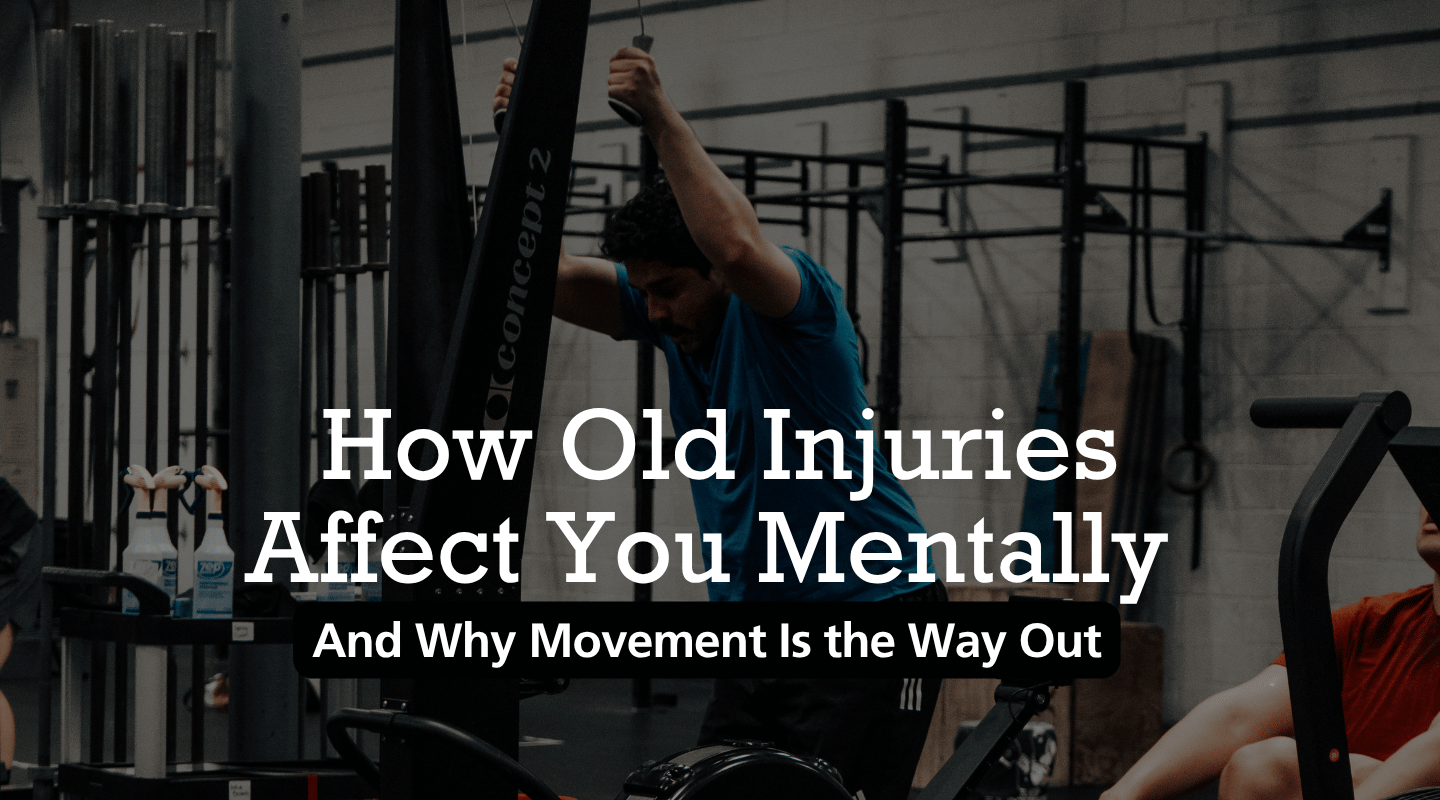

Old injuries can change how you move, think, and live—especially if they happened years ago. The physical damage heals. The mental impact can stick. If you’re in Newark, DE and ready to stop letting pain from the past run your life, smart movement and coaching can help.
Everyone remembers their “big one.”
Back tweak. Torn ACL. Shoulder surgery. Car accident.
The physical healing might be over, but your brain doesn’t always get the memo. You move differently. Hold tension. Avoid certain exercises. Worry more. Confidence takes a hit.
You’re not crazy. It’s your brain doing what it’s designed to do—protect you. The problem? It can overprotect. That’s where people get stuck.
This is the biggest one. Let’s say you hurt your lower back deadlifting 4 years ago. Since then, you avoid bending over too fast, lifting anything heavy, or deadlifting at all. The pain is gone, but the fear isn’t.
This fear can:
That story plays over and over in your head: “If I try this, I’ll get hurt again.” And so you don’t try.
If you used to be an athlete, runner, lifter—or just someone who was active—and an injury changed that, the mental fallout can be brutal.
You don’t feel like “you” anymore.
You feel slower, weaker, older.
You start to label yourself as “injured” or “broken.”
That shift in identity leads to withdrawal. People stop doing the things they love. That has a direct impact on mood, motivation, and mental health.
Your brain keeps scanning for danger. One small twinge and suddenly you're spiraling:
"What if I made it worse?"
"This means I can’t work out anymore."
"I’m just getting older and falling apart."
These thoughts become automatic if left unchecked. Over time, they can contribute to chronic pain—even when no physical damage remains (CDC source).
You don’t just avoid movements. You avoid social stuff too. Group workouts, sports leagues, long hikes, even walking the dog becomes a mental challenge.
This pattern leads to:
And here’s the kicker: the less you move, the worse everything gets.
Movement.
Not random, aggressive, “push through the pain” workouts.
Smart, structured, progressive movement. With a coach. With a plan.
Every time you train and nothing “goes wrong,” your brain updates its threat map.
You start to learn:
“I can squat. I can deadlift. I can push myself again—and be OK.”
Those wins add up. It’s not about lifting heavy from day one. It’s about proving to yourself that you can move without fear.
Avoidance tells your brain, “That’s dangerous.”
Exposure says, “This is safe now.”
That’s how physical therapy works. It’s how good training works too. You’re not just moving—you’re rewiring your brain’s belief system.
You’ll go from “I’ll get hurt if I do that” to “I know how to do this safely.” Big shift.
This one’s simple but real. Movement helps mood. Strength training especially. It improves sleep, lowers anxiety, and helps with depression (WHO supports this).
The moment you start training again—even if it's light—you get that psychological lift.
Training is a reminder:
“I can still improve. I can take control again.”
That’s huge for people who’ve felt stuck in “recovery mode” for years. You stop feeling broken. You start feeling capable.
At Hardbat Athletics in Newark, DE, we’ve worked with people recovering from:
We’re not doctors. We don’t diagnose or treat injuries. But we do work hand-in-hand with where your rehab ends—and your comeback begins.
Our Personal Training and Small Group Training are built around your movement history. No cookie-cutter stuff. We assess, adapt, and progress you.
You’ll rebuild strength, range of motion, and stamina. More important: you’ll rebuild belief in your body.
One of our members came in after two years of post-op hesitation from a meniscus repair. They had done all the PT but still wouldn’t lunge, run, or squat heavy.
We started with bodyweight work, then loaded carries, then trap bar deadlifts with a block under it (limited range). Six months in, they were sprinting again. But even more important—they weren’t afraid anymore.
That’s what training gives you: not just strength, but trust in your own body.
You don’t need to figure this out alone. A coach helps you move with confidence, avoid risky patterns, and adjust on the fly. Plus, accountability helps.
Book personal training if you’re ready for 1-on-1.
You’re not trying to go back in time. You’re trying to move better now. Let go of the “I used to bench 275” voice in your head. Start with where you are—not where you were.
Every session that doesn’t flare you up is a win. Every pain-free movement is proof. Keep a log. Watch the progress stack.
Our small group fitness lets you train around others without the chaos of a big gym. You’ll get support, coaching, and a dose of healthy energy.
This one’s key. Sometimes the brain interprets stress or tension as pain—even when nothing is structurally wrong. Working with coaches who understand this difference helps you navigate it the right way.
You don’t have to train scared forever. You don’t have to avoid movement. And you don’t need to stay stuck in a holding pattern because of something that happened 5, 10, or even 20 years ago.
You just need a plan, the right environment, and a coach who knows how to rebuild from the inside out.
👉 Ready to reclaim your body and confidence?
Book a No-Sweat Intro with a coach at Hardbat Athletics in Newark, DE. Let's talk about your injury story—and where you want to go next.